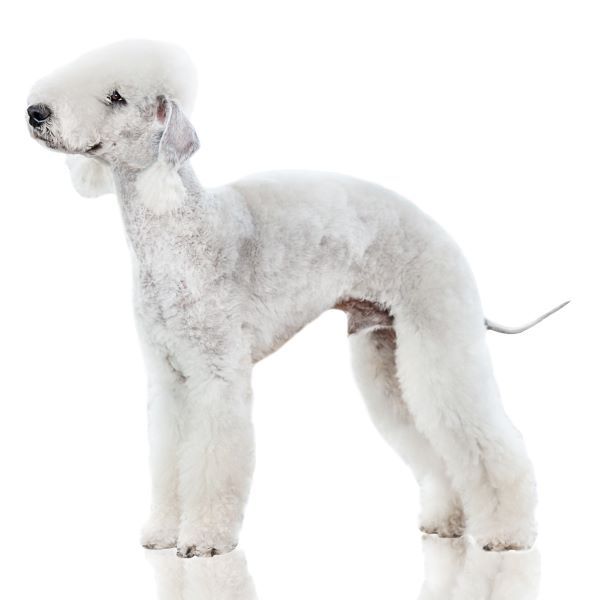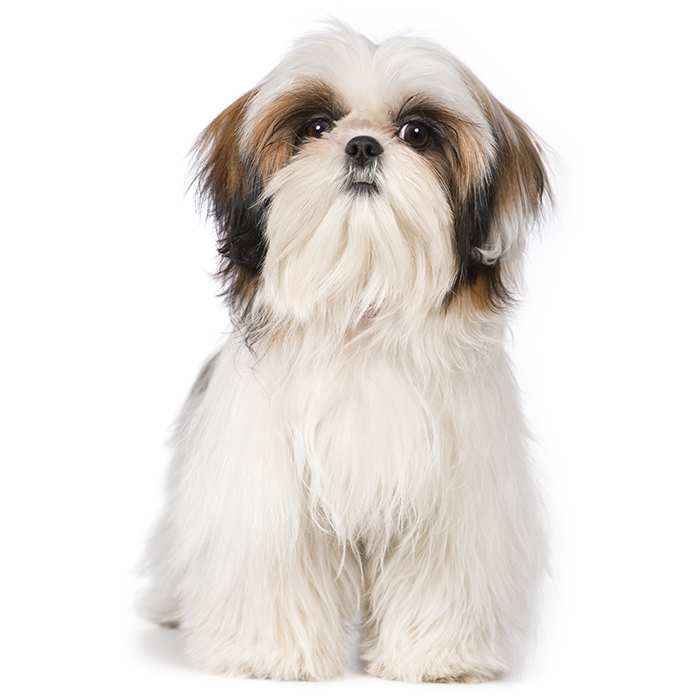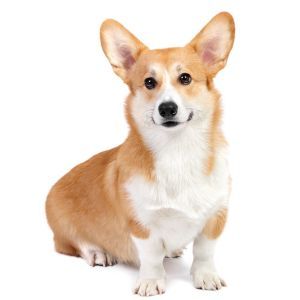Miniature Dachshund
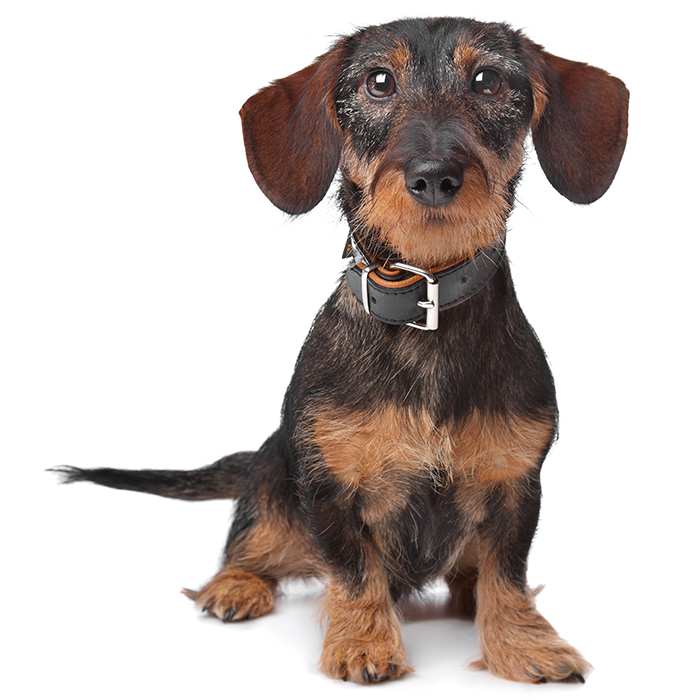

| Recommended for | Singles & families |
| Breed Classification | Hound |
| Other names | Doxie, Sausage Dog |
| Lifespan | 12-15 years |
| Size | Toy |
| Temperament | Independent, loyal, brave, devoted |
| Intelligence | Above average |
| Tendency to bark | High |
| Maintenance Level | Low |
| Health Risk | This breed has an around average probability of having health issues in its lifetime, hence it is one of the more affordable breeds to insure. |
Insuring a Miniature Dachshund?
Get our award-winning Nose-to-Tail Cover with up to $30k annual benefit limit, up to 90% of eligible vet bills back, and no sub-limits.
Get a quick quote
Is this breed right for you?
Try our breed selector quiz to find out your best matching breed!
Insuring a Miniature Dachshund?
Get our award-winning Nose-to-Tail Cover with up to $30k annual benefit limit, up to 90% of eligible vet bills back, and no sub-limits.
Get a quick quote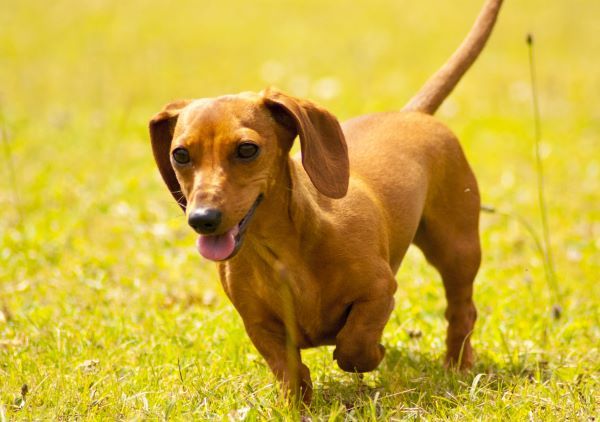
Breed history of Miniature Dachshunds
Although it has never been firmly established which breed or breeds were used to develop the Dachshund, we do know that the breed originated in Germany where they were known as “badger dogs” (in German, the word ‘dachs’ means badger and the word ‘hund’ means dog). There are illustrations of Dachshunds dating back to the fifteenth Century, as well as eighteenth century books that refer to a breed of dog called the ‘badger crawler’ and ‘badger warrior’.
German foresters needed a dog small enough to go to ground, with a good nose to find its quarry , a loud bark and a courageous nature. Because of their low, flat body, Dachshunds proved useful for hunting small prey as they could crawl into their dens. At the time, the size of the Dachshund varied and larger dogs were used to catch badgers and track wild boar, while the smaller dogs were used to hunt foxes and rabbits and to track down wounded deer.
The breed was refined in Germany over time. During the 1800’s, Dachshunds were bred more for pets than hunters. They became popular in Great Britain and were a favourite of Queen Victoria. Their popularity led to the breeding of smaller Dachshunds, and in 1910, stricter breeder criterias were adopted related to size.
During World War 1 and World War II the Dachshund’s popularity floundered in the United Kingdom because of their association with Germany. Today, their popularity has been reestablished and the Miniature Dachshund is a popular dog right across the world.
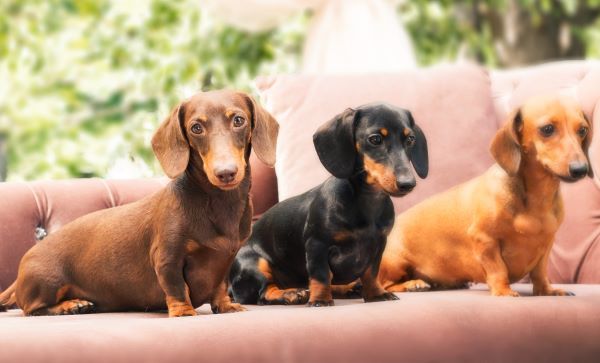
Physical description of Miniature Dachshunds
Dachshunds come in two sizes: Standard and Miniature. The Miniature is Standard in a reduced size; while the Standard ideally weighs from 9 to12 kg, the Miniature weighs under 5 kg.
Miniature Daschunds, just like their bigger siblings, have an unmistakable long-backed body, short little legs and an ever-alert expression. They have a long muzzle and almond shaped eyes that can either be dark red or black-brown.
There are three varieties of coat type: smooth-haired, wire-haired and long-haired. The smooth-haired is probably the best known, being the dense, short and smooth coat popularised in the media. The long-haired coat is soft and straight or slightly wavy, and longest under the neck, the underparts of the body, behind the legs where it forms abundant feathering, and on the tail where it forms a flag. The wire-haired has a close-fitting, straight, harsh double coat with a goatee beard and bushy eyebrows.
Miniature Dachshunds can come in a variety of colours including red or cream, black and chocolate, dapple, sable, piebald, brindle, and wildboar. Short-haired Miniature Dachshunds are usually black, chocolate, wild boar, grey or fawn with tan or cream markings.
| Weight range | 4 to 5 kg |
| Height range | 13 to 18 cm |
| Colours | The dominant color in the breed is red, followed by black and tan. Other colours include chocolate, cream, brindle, wild boar, blue, pie bald and dapple |
| Coat length | Short or medium |
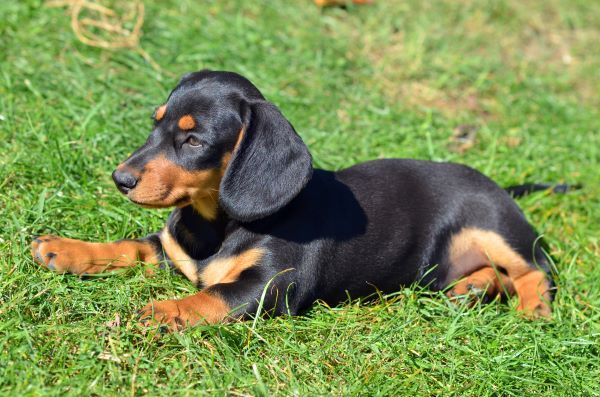
Miniature Dachshund personality and temperament
Miniature Dachshunds, or Doxies as they are affectionately known, have loveable temperament and a bright personality. They make great family pets and very devoted and loyal companions, loving nothing better than curling up under a blanket with their owners. Because they are very social, Dachshunds don’t do well as outdoor dogs; they want to be with their humans having regular interaction with them.
Lively and vigilant, with a big-dog bark, Dachshunds make fine watchdogs. They can be standoffish towards strangers and may growl or bark at them. Bred to be an independent hunter of dangerous prey, they can be brave to the point of rashness, with a big attitude and stubbornness to match.
Dachshunds don’t need a lot of space and make ideal apartment dogs as long as they can get the exercise they need. Leaving a Dachshund for alone for long periods of time can lead to them becoming anxious and vocal.
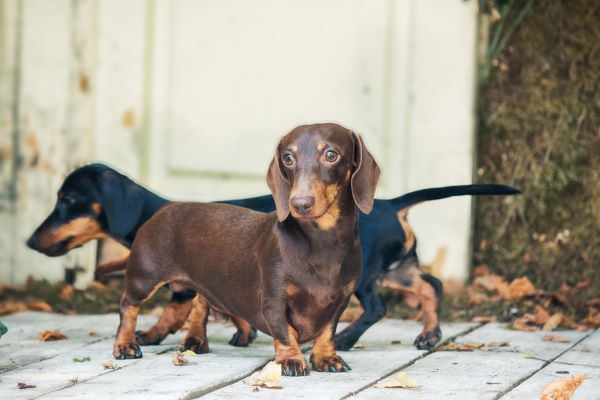
Miniature Dachshunds with kids and other pets
Miniature Dachshunds are very tolerant and loyal to children within their family. While they are therefore suitable for families, Dachshunds may not be the best pets for small children because their long back can be injured if they are not handled with care.
Well trained Dachshunds usually get along fine with well behaved children. Otherwise, they may be aggressive and bite an unfamiliar child, especially one that moves quickly around them or teases them.
Dachshunds are pack animals who need to have regular companionship and they enjoy the company of other dogs, especially other Dachshunds.
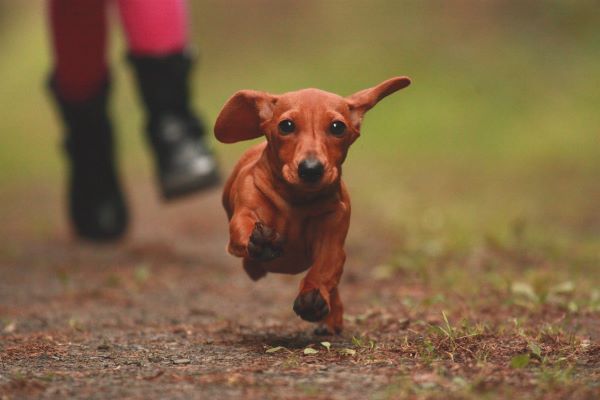
Miniature Dachshund training and exercise
Miniature Dachshunds aren’t built for distance running, leaping, or strenuous swimming, but nevertheless, these tireless hounds thrive on exercise and need a daily walk. They make good companions for older people as they don’t require a huge amount of exercise. It’s always best to keep them on the lead during walks because they have a strong hunting drive and will take off if they catch a scent.
Miniature Dachshunds need regular exercise not only to stay fit, but also to build strong muscles to support and protect their back. To avoid injury, never allow a Dachshund to run up and down stairs or jump on or off furniture.
Dachshunds are very intelligent but are also independent and often stubborn, so they can be a challenge to train. Persistence and patience are key. They love to give and receive affection and do best with positive, reward-based training. They are sensitive and will not react well to harsh commands or punishment.
| Energy level | High |
| Exercise requirements | Medium |
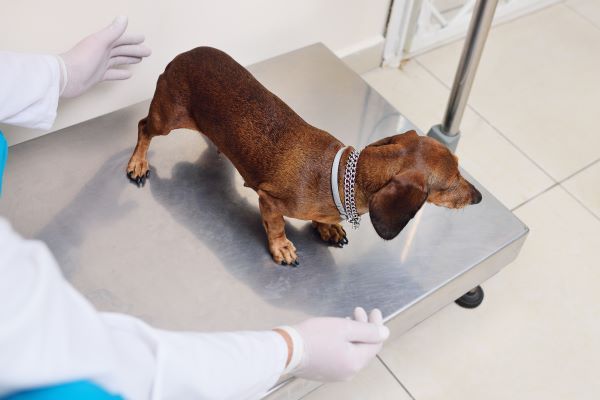
Miniature Dachshund feeding and nutrition
The Miniature Dachshund should do well on a high-quality dog food appropriate to the dog’s age (puppy, adult, or senior) and activity level.
This breed is prone to weight problems, particularly if overfed and/or under-exercised. They love food and tend to want to eat anything in sight. However, it is extremely important that a Dachshund not be allowed to become overweight. This is not only because of general health reasons, but also to avoid straining the Dachshund’s long back, which can lead to spinal injuries.
Be vigilant in monitoring your Miniature Dachshund’s calorie consumption and weight level and only provide the recommended portion size at meal times. Keep foodstuffs well out of the dog’s reach, and be aware that treats and table scraps can contribute to weight gain and obesity. Always check with your vet if you have any concerns about your dog’s weight or diet.
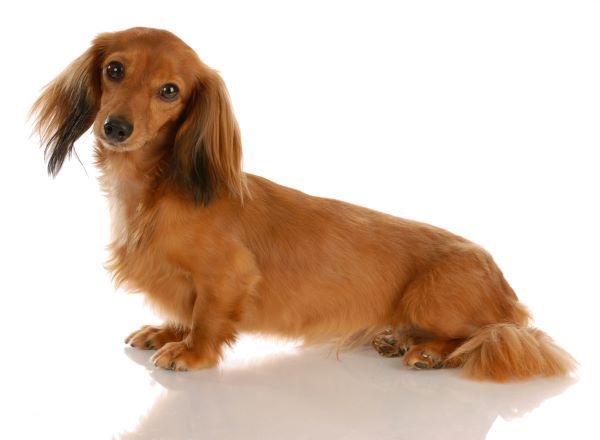
Miniature Dachshund care and grooming
Miniature Dachshunds’ grooming needs vary depending on their coat type. The smooth-haired coat doesn’t require much mored than a weekly brush and/or a wipe with a towel to maintain. The long-haired coat requires more frequent brushing, depending on the thickness of the coat, to keep in good condition. For the wire-haired coat, plucking or hand-stripping several times a year will keep it looking its best, and it is easy to maintain between groomings with occasional trimming of the beard and eyebrows and weekly or twice weekly brushing or combing.
All coat types are moderate shedders, relatively clean, and have little or no body odour. The breed’s pendulous ears make them susceptible to ear infections, and should therefore be cleaned weekly.
Health issues for Miniature Dachshunds
- Intervertebral Disc Disorder (IVDD) is a condition that occurs when the discs between the vertebra become damaged.. In dogs, there are two primary disorders that can affect the intervertebral discs, namely, a herniated disc or intervertebral disc disease. In these conditions, the disc or discs can become displaced, deteriorated, collapsed, bulging or protruding, causing pain and neurological problems. Hansen Type I IVDD is an acute, progressive chondroid (cartilage) degeneration of the disc that commonly affects the Dachshund, with Miniature Dachshunds having a lifetime prevalence of about 20%.
- Epilepsy, a general term for neurological disorders that bring on sudden and repeated seizures, can occur in Dachshunds; it can either be hereditary or the result of a knock to the head. Symptoms can vary depending on the underlying cause and the severity of the seizures. Epilepsy is typically a chronic disease requiring life-long treatment and care.
- Progressive retinal atrophy refers to a family of inherited eye conditions which lead to the gradual deterioration of the retina, causing first night blindness, then full blindness. There is no cure, but many dogs adapt easily to the loss of sight and can lead relatively normal lives, as long as their environment does not change too drastically.
- Gastric Dilatation-Volvulus, also known as bloat, is a potentially deadly condition. Risk is increased if the dog is fed one large meal a day, eats quickly, drinks large amounts of water or exercises after eating. The stomach twists, making the dog unable to belch or vomit to get rid of excess air, and as a result the blood supply to the heart is impaired. Unless immediately attended to, the dog may die. Symptoms of bloat include a distended belly, excessive drooling, dry having, restlessness, exhaustion, weakness and a quick heart rate.
- Cushings Disease, orHyperadrenocorticism, is one of the most common endocrine disorders that affects dogs. Characterised primarily by overproduction of the hormone cortisol, this condition can occur as the result of an imbalance in the pituitary or adrenal gland or when the dog has too much cortisol as the result of other conditions. The symptoms of this disease include excess urination and excess drinking.
- Diabetes is a metabolic disease that occurs when the body cannot regulate blood levels. Diabetes in dogs is classified as Type 1 or Type 2, as it is for humans. Affected dogs do not lose their appetite, but will often lose weight, urinate a lot and get thirsty often. It is treated with a special diet and insulin.
Not all conditions are covered by Pet Insurance. For details of Bow Wow Meow Pet Insurance cover, refer to the Product Disclosure Statement.
Thinking about insuring a Miniature Dachshund
Thinking about insuring a Miniature Dachshund
Learn moreThinking about insuring a Miniature Dachshund
Learn moreFree engraved pet ID tag on sign up3
Customer Satisfaction
21 day cooling off
Easy to use Pet Portal

GapOnly® in vet claims
MORE INFORMATION
The Dachshund Club of Queensland: https://dachshundclub.com.au/
The Dachshund Club of NSW Inc: http://www.dachshundclub.org.au/
The Dachshund Club of Victoria Inc: http://www.dachshundaustralia.org.au/

